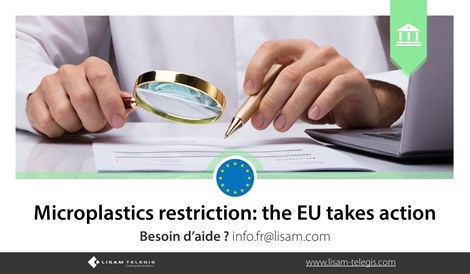Microplastics restriction: the EU takes action
Microplastics restriction: the EU takes action
lundi 16 octobre 2023
 Microplastics are small solid particles of plastic, generally less than 5 mm in size. They can be generated unintentionally by the fragmentation of larger pieces of plastic, but they can also be manufactured by humans to be intentionally incorporated into products (granular fillers used on artificial turf sports pitches, fertilisers, cosmetics, etc.). It is this second category that is targeted by the restriction on microplastics that we will discuss below.
Microplastics are small solid particles of plastic, generally less than 5 mm in size. They can be generated unintentionally by the fragmentation of larger pieces of plastic, but they can also be manufactured by humans to be intentionally incorporated into products (granular fillers used on artificial turf sports pitches, fertilisers, cosmetics, etc.). It is this second category that is targeted by the restriction on microplastics that we will discuss below.There are many concerns about microplastics. Firstly, they are a source of massive environmental pollution: non-biodegradable, they accumulate in marine, freshwater and terrestrial ecosystems and are ingested by marine species, with toxic and functional repercussions. They are also found in the food we eat and the water we drink, representing a potential risk to human health. Currently, the European Chemicals Agency (ECHA) estimates that around 42,000 tonnes of microplastics are released into the environment each year in Europe (through the use of products where they are intentionally added).
In January 2019, ECHA submitted a restriction dossier under Annex XV of the REACH Regulation concerning the use of microplastics in products placed on the European market, in which it concludes that the intentional use of synthetic polymer microparticles poses a risk to the environment that is not adequately controlled and needs to be addressed at EU level. Its aim is to prevent the release of half a million tonnes of microplastics into the environment over 20 years. ECHA's Risk Assessment Committee (RAC) adopted its opinion in June 2020, followed by the Socio-Economic Analysis Committee (SEAC) in December 2020: they both supported ECHA's proposal, but made several recommendations.
The restriction on microplastics was finally adopted by the European Commission on 25 September 2023, with the addition of entry 78 to Annex XVII of the REACH Regulation.
The full text, "Commission Regulation (EU) 2023/2055 of 25 September 2023 amending Annex XVII to Regulation (EC) No 1907/2006 of the European Parliament and of the Council on the Registration, Evaluation, Authorisation and Restriction of Chemicals (REACH) as regards synthetic polymer microparticles", is available here. This restriction will be phased in over 12 years, depending on the type of product, and the first measures will start to apply tomorrow (e.g. the ban on loose flakes and microbeads). These specific transitional periods are intended to give the stakeholders concerned sufficient time to comply with the restriction and make the transition to appropriate alternatives, such as degradable polymers.
More broadly, this restriction is part of the European Union's action plan entitled "Towards zero pollution of air, water and soil", in which the Commission has set the objective of reducing pollution by microplastics by 30% by 2030.
